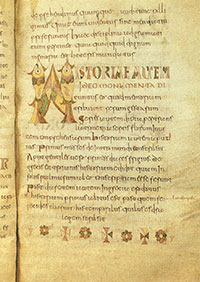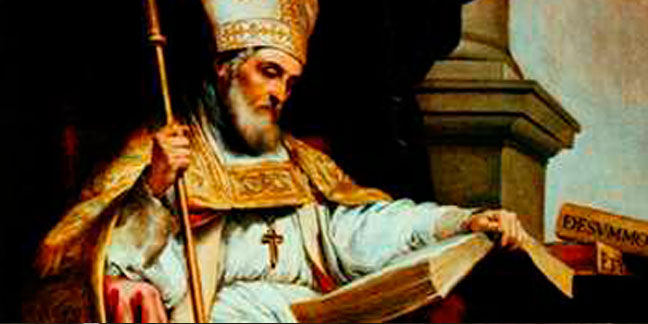St. Isidore is the patron saint of the Internet and the author of the first encyclopedia ever written, called "Etymologiae." In 20 volumes, St. Isidore compiled all of the learning of his day. Throughout the greater part of the Middle Ages and the Renaissance, it was the textbook most used in schools.
St. Isidore was born in Cartagena, Spain, around the year 560 and succeeded his older brother as the archbishop of Seville. He was a prolific writer on the Scriptures and theology, as well as on the knowledge of his day in the fields of physics, astronomy, history and geography. He also wrote a dictionary of synonyms.
During his episcopate, the classic learning institutions of the Roman Empire were being destroyed by the barbarous Goths, who were in power in Spain. In an effort to counter this, St. Isidore encouraged education and the study of law, medicine and the liberal arts. He eradicated Arianism and other heresies and reinforced religious discipline.
At the Second Council of Seville, begun Nov. 13, 619, St. Isidore persuaded all bishops to establish seminaries in cathedral cities, making education an obligation for all bishops.
 Detail of a page from St. Isidore’s “Etymologiae,” a Carolingian manuscript dating from the eighth century, at the Royal Library of BelgiuHe also had great admiration for monks and wrote a book called "Regula monachorum" on the monastic life, though he wasn't a monk himself. In it, he said religious life is proof of true Christian democracy by admitting men of every rank and station of life.
Detail of a page from St. Isidore’s “Etymologiae,” a Carolingian manuscript dating from the eighth century, at the Royal Library of BelgiuHe also had great admiration for monks and wrote a book called "Regula monachorum" on the monastic life, though he wasn't a monk himself. In it, he said religious life is proof of true Christian democracy by admitting men of every rank and station of life.
"God has made no difference between the soul of the slave and that of the freedman," he wrote. In the monastery, he said, all are equal in the sight of God and of the Church.
St. Isidore was the last of the ancient Christian philosophers and great Latin Fathers. He died April 4, 636, and his feast is celebrated each April 4.
— Source: Catholic News Agency
What is a Doctor of the Church?
Doctors of the Church are great saints known for their defense and explanation of the truths of the Catholic faith. The original eight Doctors of the Church were named by acclamation, or common acknowledgment. The rest have been named by various popes, starting with the addition of St. Thomas Aquinas to the list by St. Pius V in 1568.
The title “Doctor of the Church” indicates that the writings and preachings of such a person are useful to Christians “in any age of the Church.” Such men and women are particularly known for the depth of understanding and the orthodoxy of their theological teachings. Through their research, study and writing, they have advanced the Church’s knowledge of our faith.
While the writings of the Doctors are often considered inspired by the Holy Spirit, this does not mean they are infallible. It does mean that they contributed significantly to the formulation of Christian teaching in at least one area, and that their work overall serves to advance the cause of Christ and His Church.
The title was first given in the Middle Ages. Originally, there were four great Doctors of the Church: St. Ambrose, a fourth-century bishop of Milan; St. Augustine, a fifth-century bishop of Hippo; St. Gregory the Great, who was pope at the start of the seventh century; and St. Jerome, the fifth-century biblical scholar and translator.
Today, there are 37 Doctors of the Church: 28 from the West and nine from the East.
— USCCB
Read more about the Doctors of the Church



